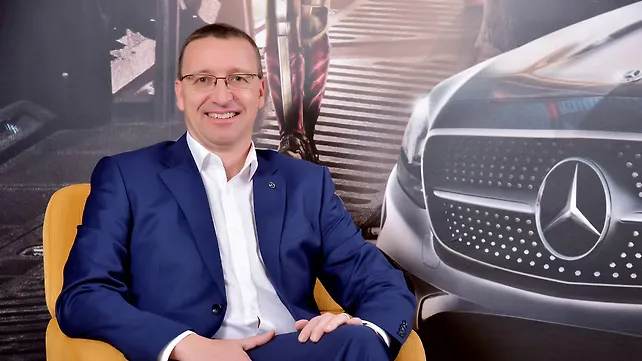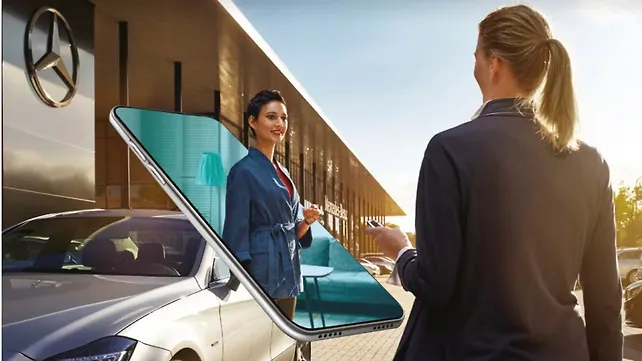
India’s largest luxury carmaker, Mercedes-Benz India (MBIL) has announced that it will sell all its new cars directly to the customer, via the company’s own centralised inventory and through its dealer partners.
In what promises to be a win-win model for customers, dealer partners and for the company itself, Mercedes-Benz India plans to standardise the pricing across the country, where there will be no financial burden on dealers to hold inventory, making them viable and profitable.
Terming it as Retail of the Future (ROTF), Martin Schwenk, Managing Director and CEO, MBIL said the company believes this long-term strategic move will strengthen its customer focus by introducing a fundamental transition in the retail business in the market. It also will deliver a win-win solution for both customers and franchise partners, he said.
“It empowers customers to have a hassle-free and completely transparent customer journey, experienced never before. We are empowering dealer partners to have significantly less financial and operational risks, resulting in a profitable and sustainable business model,” he added.
Traditionally, carmakers upfront bill the inventory to its dealers, who get prospective customers and sell vehicles. This gave them the flexibility to cross boundaries and territories to sell more cars and get more business.
How does ‘Direct To Customer’ sales model work?
What does the ‘Direct To Customer’ sales model hold for dealers and customers? Mobility Outlook spoke to various dealers and auto retail experts to find out whether it will be feasible for mass-car players?
Under this new model, carmakers will own the entire stock of cars, sell them via appointed franchise partners, invoice the new cars to the customers directly, process the order and fulfil them, offering one transparent price and purchasing experience for customers.
The primary roles and responsibilities of the dealers include establishing and maintaining customer contacts, developing the market and facilitating the sale of cars. Other than this, the other business components such as used cars, sales and service will function as usual.

Terming it as brilliant and in line with the future of mobility, Amit Kaushik, Managing Director and Country Head, Urban Science said, “Since the dealers don't need to carry inventory, the model will lead to a more profitable and healthy balance sheet for the partners. Potentially in near future, the fixed infra cost including resources and showroom will also go down substantially.”
Success of the model would depend on how the loose dots of model are connected during execution and how the compliance and governance part is taken care of from a sustainability standpoint, Kaushik said.
From this, a customer located in a remote area can now order a car and get it hassle-free, without having to travel long distances. The overall reach for the carmaker will increase, Kaushik said.
However, Vinkesh Gulati, President, FADA thinks it will be counterproductive as the dealers, who want to work with aggression and sell more vehicles, will lose business now and there will be overall complacency in dealers in the long run. He nonetheless applauded the move, and said about 1.5% of the car price, which is the inventory keeping cost, will be saved and inventory time will be reduced significantly.
According to an estimate, about 40% of the dealership business comes by selling outside their regional territory.
What does the new sales model mean to dealers?
There have been talks about this model bringing in financial benefits to dealers as there will be no inventory cost, but it will have a significant impact on margins as it has come to half in form of commissions.
According to a Mercedes-Benz India dealer, who on condition of anonymity told Mobility Outlook that they used to earlier earn 10-10.5% margin on every sale, which has now come down to 5-5.5%; even when the cost of selling a vehicle remains the same.
Another dealer pointed out that, despite the margins being reduced, he expects price undercutting by dealers within the same brand to go away, as the customer will get the offers directly from the company.
From the competition perspective, Mercedes-Benz India might have a tough time ahead. For example, customers looking to but a Mercedes E Class or a BMW 5 Series, might go for the brand that offers better discount. Also, customers in India are not ready to take strict and blunt answers, when it comes to negotiating car prices, the dealer argued.
Globally, carmakers like Tesla have proven this model. Even for MBIL, India will be the fourth market to adopt the direct to customer sales model after introducing the model in Sweden, South Africa and Australia. The luxury carmaker aims to get 25% of new cars sales via online sales channel by 2025.
What does it mean to customers?
The whole strategy of ‘Direct to Customer’ sales model is devised keeping the customer at the centre stage. The customers can avail best price directly from Mercedes-Benz India and transparent price comparison across the product range. Also, it will be much simplified purchase process, which is seamless and hassle-free.
Though touch, feel and experience hold its own relevance in India, Kaushik said going forward, with young achievers, millennials and rising internet penetration, this model will certainly help improve efficiencies. However, one standard price by the carmaker might act as hindrance initially as Indians love discounts.
Can this model work for mass market car players?
No. Experts indicated that this model can work only for limited volume players as there is less number of invoices to be generated and there is less paperwork.
For carmakers like Maruti Suzuki and Tata Motors, which sell between 15 lakh and 8 lakh cars respectively, per annum, the ‘Direct to Customer’ sales model is not feasible, said Gulati. As the carmakers will need to take GST numbers for all states and get into the paperwork.
Mercedes-Benz India, which operates in 20-22 regions, can do it easily with less volumes. The company plans to start ROTF model from October 2021.